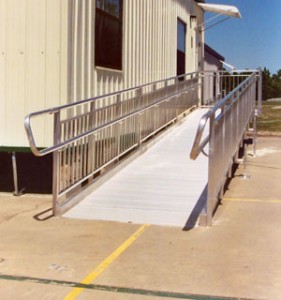 Ramps are the most common way to address building accessibility issues. Wheelchair ramps help you meet ADA guidelines and are ideal for people who use wheelchairs, scooters, or who struggle with stairs. REDD Team’s universal aluminum ramps and universal stairs are perfect for almost any site.
Ramps are the most common way to address building accessibility issues. Wheelchair ramps help you meet ADA guidelines and are ideal for people who use wheelchairs, scooters, or who struggle with stairs. REDD Team’s universal aluminum ramps and universal stairs are perfect for almost any site.
REDD Team is a leading national manufacturer of high quality aluminum access products. When choosing the best wheelchair ramp for your site-built or modular building, school, place of worship, etc., our ramps offer the greatest number of options, the best strength and durability, and require virtually no maintenance. Here are a few benefits:
1. Versatile – Our aluminum ramping can be configured to access any size and type of entrance. Ramps can be easily disassembled, reassembled and/or reconfigured if you need to move them to a different location.
2. Strong and durable – Aluminum is stronger and more durable than wood and is non-corrosive and non-combustible. It doesn’t rot, splinter or burn like wood, and does not require any painting or coating to preserve it.
3. Safe – Our ramps feature smooth, continuous handrails and a slip resistant walking surface for safe and easy access.
4. Easy installation – Installing REDD Team universal ramp systems is easy. No field welding is required, and even the most complex ramps can usually be assembled in less than a day. Wood ramps, in comparison, can take two or more days to install and finish.
5. Low maintenance – Aluminum is a virtually maintenance-free metal and offers exceptional value over a long life cycle.
We offer a complete line of products, such as modular ramps, portable ramps, commercial stairs, ramps, pedestrian bridges, and walkway systems, crossover stairs, aluminum viewing platforms, and portable aluminum work platform porches that will meet your needs and budget.
ADA Ramp Standards
In general, the ADA Standards for Accessible Design impose the following minimum requirements on wheelchair ramps for State and local government facilities, public accommodations, and commercial facilities:
- Ramp runs must have a running slope not steeper than 1:12; however, there are exceptions for existing sites, buildings, and facilities that have space limitations.
- Cross slope of ramp runs must not be steeper than 1:48.
- Changes in level other than the running slope and cross slope are not permitted on ramp runs.
- The rise for any ramp run must be a maximum of 30 inches.
- The clear width of a ramp run and, where handrails are provided, the clear width between handrails must be a minimum of 36 inches.
- Ramps must have landings at the top and the bottom of each ramp run.
- Ramp runs with a rise greater than 6 inches must have handrails; however, there are exceptions for certain employee work areas.
- Edge protection must be provided on each side of ramp runs and at each side of ramp landings, except for the sides of ramp landings serving an adjoining ramp run or stairway or ramps that are not required to have handrails.
- The floor or ground surface of the ramp run or landing must extend at least 12 inches beyond the inside face of a handrail to prevent wheelchair casters and crutch tips from slipping off the ramp surface.
- Landings subject to wet conditions must be designed to prevent the accumulation of water.
Our universal ramp systems meet these and other ADA standards. They also meet IBC, SBC, BOCA, SREF, UBC and Life Safety 101 code requirements.
REDD Team has the tools and knowledge to correctly assess and measure your property for aluminum ramps, and can help you with building codes and other local regulations that may apply to you.
Get in touch with us at (800) 648-3696 to find out how our aluminum access solutions can solve your accessibility issues.

